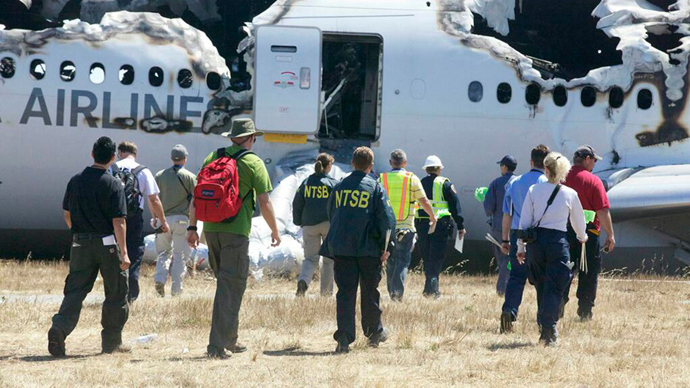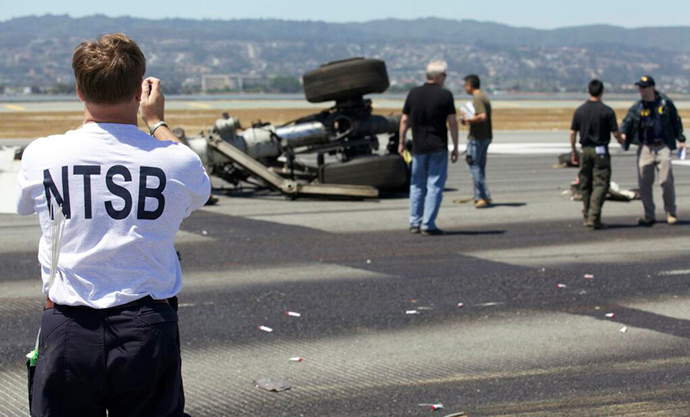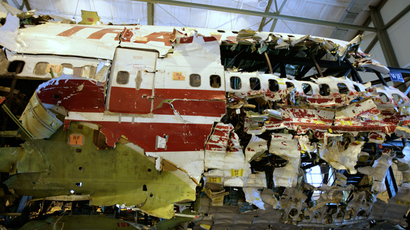With 'inexperienced’ pilots at the helm, Boeing came in ‘below-speed’ before SF crash

The Boeing 777 that crashed at San Francisco airport on Saturday was flying so slowly that it was on the verge of stalling before hitting a seawall, investigators said Sunday. Two of the 307 passengers were killed and dozens more injured.
Officials stressed that the investigation into the cause of the crash was ongoing but Asiana Airlines, which operated the jetliner, has admitted that the pilot and flight trainer both had little experience in their respective roles.
After studying flight recorder telemetry and pilot radio conversations U.S. National Transportation Safety Board Chairwoman Deborah Hersman said Flight 214 approached the tarmac at 103 knots, or 119 mph, which is "significantly below the target air speed” of 137 knots, or 157 mph.
"We are not just talking about a few knots here or there," Hersman told the media. “We are certainly looking at pilot performance, and we’re looking at communication between the two crew members. But everything is still on the table.”
Hersman added that a “significant piece” of the tail of the aircraft was found in the San Francisco Bay and that other parts of the plane were visible in the water at low-tide, indicating it struck the seawall.
Lee Gang-guk, the flight captain, is an experienced pilot with nearly 10,000 hours logged in flight. But he had completed only 43 hours and nine training flights on the 300-plus capacity Boeing 777, although he had landed at the airport nearly 30 times before in other aircrafts.
Asiana has defended on-the-job training of pilots as “standard practice” in the industry.
But Lee Jung-min, the senior trainer on the flight, who was
supposed to guide his colleague during the most difficult part of
any aerial journey, himself only received his training
certificate last month. This was his first flight as a trainer.
Asiana, South Korea’s second biggest airline, says it is not
aware of any technical difficulties on the 7-year-old plane, but
said it was “not appropriate” to blame the pilots until
the investigation is completed.
“For now, we acknowledge that there were no problems caused by the 777-200 plane or engines,” company president Yoon Young-doo said during a press briefing in Seoul.
On a clear afternoon, it appears as if the pilots have misjudged the descent, disabling the throttle too early or at too low an altitude to reach the landing strip of SFO, which is located on the edge of water.
Recordings indicate no distress signals from the pilots until it was too late.

Seven seconds before the crash, one of the cockpit crew called for an increase in throttle, and three seconds later, the control yoke began to shake violently – warning the pilots the plane was about to stall.
Less than two seconds before the crash, the pilot called to abort the landing, tried in vain to pull the plane back up.
"The pilots were very slow in this critical phase of flight," said Hersman.
"Right before touchdown, I felt like the plane was trying to take off. I was thinking 'What's happening?' and then I felt a bang," cabin manager Lee Yoon-hye told San Fracisco media.
The plane then snagged the sea barrier at the edge of the landing strip, flipped and hit the tarmac.
Investigators said they will also analyze the role pilot fatigue may have played in the accident. The flight originated from Shanghai, China and stopped in Seoul, South Korea before departing across the Pacific Ocean.
Four pilots were on board the plane so the pairs could keep alert with rest periods, although long-distance pilots told the Associated Press sleep is hard to come by on such flights.
“Fatigue is there. It is a factor,” said former Delta Air Lines chief international pilot Kevin Hiatt. “This is one of the issues the NTSB will be looking at with the Asiana crew, which is what were you doing in the 24 hours before flight? Did you actually sleep?”
Because of how long the pilots had been at the helm, the landing time coincided with their bodies’ circadian low – when a human naturally craves sleep no matter how rested they are.
Due to what investigators have called the “structural integrity” of the plane, the fact that the fuel tanks were nearly empty, and fast actions of the crew, the vast majority of the 305 people on-board escaped unscathed.
Two Chinese teenage girls on their way to a summer school – Wang Linjia, aged 16, and Ye Mengyuan, 17 – died after being thrown from the disintegrating fuselage. It is likely one of the two victims was killed by one of the firefighting vehicles speeding towards the crash site.
"One of the deceased did have injuries consistent with those of having been run over by a vehicle," said a spokesperson for the San Francisco Fire Department. Hesman said that possibility is “a very serious issue.”
“I can tell you that the two fatalities were located in the seats towards the rear of the aircraft,” Hesman said of the girls’ location on the plane. “This is an area of the aircraft that was structurally significantly damaged. It’s an area where we’re seeing a lot of the critical or serious injuries.”
Over 180 people went to the hospital as a precautionary measure but only a small number needed any medical attention. Less than 20 people remained hospitalized Monday,, but six of them are critically injured, including a child, and two are likely to be paralyzed.
Saturday’s botched landing is the second accident and the first fatal crash in the 18-year service history of the Boeing 777 (a BA plane also crash landed at Heathrow due to engine failure in 2008, but no one died). The US-made plane has logged more than 5 million successful flights.














